Core Evaluation Question V
To what extent is the context supportive of the LSC vision for effective science and mathematics education?
The major emphasis of the LSC is on professional development to enable teachers to effectively implement high quality instructional materials. At the same time, NSF recognized the need for projects to look at the entire system in these districts, not only professional development and instructional materials, but also policies related to student assessment; teacher recruitment, orientation, and evaluation; and systems for purchasing/managing materials and supplies. Clearly, the support of key stakeholders for the reform effort is crucial, not only from district and school-level administrators, but also from parents and the larger community. Finally, NSF hypothesized that reforms would be greatly enhanced if they had the support of business and industry; colleges and universities; and other 'science-rich' institutions.
The core evaluation includes information about the supportiveness of the context for reform from a number of sources. In questionnaires and interviews, teachers were asked about the support they receive from parents, principals, and other teachers in their schools. Principals were also asked about their opinions in relation to science and mathematics reform, including how important they considered various reform approaches, and how well prepared they felt to support teachers in the implementation of national standards. In addition, teacher and principal questionnaires asked about the extent to which school and district policies affect science and mathematics instruction. Finally, evaluators were asked to describe the extent to which district policies and resources were aligned in support of the LSC reforms.
Teachers Perceptions of Support for Reform
Teachers in the LSC districts generally feel supported by other teachers in their schools to try out innovative ideas in science and mathematics teaching, with 72 to 80 percent of teachers agreeing with statements to that effect. Slightly fewer, from 66 to 70 percent, indicated that teachers in their school regularly share ideas and materials. Far fewer teachers (11 to 16 percent) indicated they had time during the regular school week to work with their peers on science and mathematics curriculum and instruction. (See Figure 64.)
Teacher Perceptions of Support from Colleagues
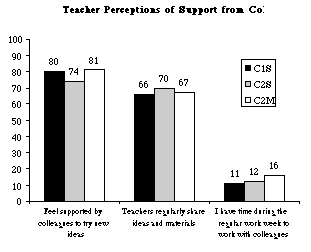
Figure 64
As can be seen in Figure 65, teachers report a fairly high level of support from their principals, with mean percentages of total possible points ranging from 67 to 80 percent on the Administrative Support composite. Table 24 shows the results for individual items included in this composite. In both science and mathematics, teachers are most likely to report that principals encourage innovative instructional practices and accept the noise that comes with an active, inquiry-based classroom. The major differences between science and mathematics are in the extent to which teachers report that their principal provides them with the necessary instructional materials and equipment and encourages them to gear curriculum and instruction to address individual students' learning.
Teachers were also asked about the extent to which parents enhanced school programs by volunteering in the classroom; donating money or materials for instruction; attending parent-teacher conferences and other school activities; and supporting the use of an inquiry-based approach to science instruction. As can be seen in Figure 66, scores on the parent support composite were lower than on other composites, with a mean of 48 percent of total possible points for Cohort 1 science, compared to a mean of 41 percent for Cohort 2 science and 43 percent for Cohort 2 mathematics.1
Composite: Administrative Support
Range of Project Means By Cohort
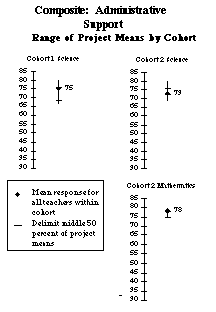
Figure 65
Composite: Parent Support
Range of Project Means By Cohort
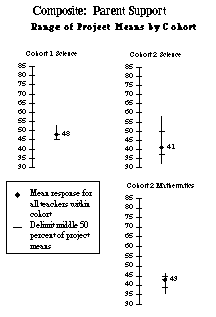
Figure 66
Table 24
Teachers' Perceptions of Principal Support for Science and Mathematics Reform
|
Percent of Classes |
|
Cohort 1 Science |
Cohort 2 Science |
Cohort 2 Mathematics |
| Accepts the noise that comes with an active, inquiry-based classroom | 82 | 81 | 80 |
| Encourages innovative instructional practices | 81 | 81 | 80 |
| Encourages teachers to make connections across disciplines | 73 | 72 | 75 |
| Encourages the implementation of current national standards in science/mathematics education | 70 | 64 | 76 |
| Acts as a buffer between teachers and external pressures (e.g., parents) | 67 | 64 | 69 |
| Encourages me to select content and instructional strategies that address individual studentfs learning | 63 | 63 | 73 |
| Enhances the science/mathematics program by providing me with needed materials and equipment | 54 | 52 | 67 |
| Encourages me to cover all the material in the prescribed curriculum | 52 | 60 | 71 |
| Provides time for teachers to meet and share ideas with one another | 38 | 42 | 47 |
| Encourages me to observe exemplary science/mathematics teachers | 28 | 29 | 35 |
Among the findings:
- About 1 in 5 Cohort 2 mathematics teachers and 1 in 3 Cohort 1 and 2 science teachers report that 'more than a few' parents volunteer in their classes.
- Parent donations of money/materials for instruction is less common; roughly 1 in 10 Cohort 2 mathematics teachers and 1 in 5 Cohort 1 and 2 science teachers report that level of involvement.
- While the majority of teachers report that more than half of the students' parents attend parent-teacher conferences, attendance at such activities as PTA meetings and Family Mathematics/Science Nights is much lower.
Teachers in Cohort 1 science projects were more likely than others to report that parents prefer the use of an inquiry approach, with 61 percent indicating that half or more of the parents felt that way, compared to 46 percent for Cohort 2 science and only 29 percent for Cohort 2 mathematics instruction.
To supplement questionnaire data, a sample of teachers in each Cohort 1 project was interviewed about support for the LSC reforms. By far, the most consistent source of support for the LSC teachers came from the principals at their schools, with more than half of the interviewed teachers reporting strong principal support. Examples of ways that principals showed their support were assuring that teachers had supplies and equipment needed to teach hands-on science, participating in professional development activities, and scheduling special events to highlight science.
Roughly a third of the interviewed teachers reported strong support from other teachers in their schools; and about 1 in 6 felt they had strong support from parents and other community members. Support from parents was sometimes quite concrete; for example, in some schools parents were responsible for running the science resource center.
An area of support that was clearly critical for many teachers was availability of materials for science instruction. Teachers in projects that were not providing materials to support the kits that were introduced in professional development complained about having to spend out-of-pocket money for supplies. Similar concerns expressed by teachers included having a limited number of kits available to teachers in their schools and apprehension about whether funding for supplies would continue over time.
Principal Views on Science and Mathematics Reform
As can be seen in Table 25, principals in LSC schools have generally favorable attitudes towards science and mathematics reform. It is interesting to note that principals were more likely to consider the use of hands-on and inquiry-oriented instruction as 'very important' for science than for mathematics. For example, 78 percent of Cohort 1 science principals said it was very important that science instruction engage students in inquiry-oriented activities, while only 68 percent of these same individuals considered inquiry-instruction essential for mathematics. Similarly, 77 percent of principals in schools targeted by the Cohort 2 mathematics projects said inquiry was very important for science; only 64 percent of those principals felt inquiry was very important for mathematics instruction.
Table 25
Principal Ratings of Importance of
Various Instructional Strategies for Effective Instruction
|
Percent Rating Each "Very Important" |
|
Cohort 1 Science |
Cohort 2 Science |
Cohort 2 Mathematics |
|
Science | Math |
Science | Math |
Science | Math |
| Hands-on instruction | 85 | 79 | 84 | 78 | 78 | 74 |
| Inquiry-oriented instruction | 78 | 68 | 82 | 72 | 77 | 64 |
| Take prior conceptions into account | 67 | 73 | 65 | 72 | 71 | 75 |
| Cooperative learning groups | 60 | 52 | 56 | 48 | 53 | 45 |
| Use informal questioning to assess student understanding | 54 | 51 | 51 | 50 | 53 | 52 |
Roughly 90 percent of the principals in each cohort indicated a willingness to accept the noise that comes with an active, inquiry-based classroom. Areas where principal support was less universal related to national standards. For example, as shown in Figure 67, only 68 percent of principals in Cohort 1 Science schools indicated that they were well-prepared to support teachers in implementing current national standards in science.
Principal Knowledge of National Standards
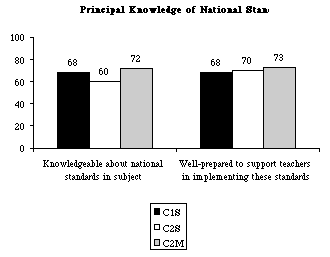
Figure 67
Teacher and Principal Views on the Policy Environment for Reform
Principals and teachers were given a list of "factors" that might affect instruction and asked to indicate the extent, if any, of the problem each caused for science and mathematics instruction. Teachers were answering about problems in their own instruction, and principals were answering about the school as a whole. From the teacher perspective, there is considerable room for improvement in the extent to which the policy environment supports science and mathematics instruction. For Cohort 1 science, the mean on the 'Alignment of District Policies' composite was 58 percent of total possible points, with project means ranging from 42 to 70 percent. For Cohort 2 science the range among projects was from 41 to 49 percent, with an overall mean of 56 percent. The mean for Cohort 2 mathematics was 62 percent, ranging from 56 to 66 percent among projects. (See Figure 68.)
Composite: Alignment of District Policies
Range of Project Means by Cohort
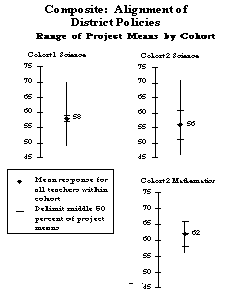
Figure 68
As can be seen in Figure 69, in both science and mathematics, lack of time to work with other teachers was the most frequently cited problem, with more than half of the Cohort 1 and Cohort 2 science teachers and nearly that many Cohort 2 mathematics teachers labeling it a major problem. Access to computers ranked second, with more than half of the teachers in science and nearly half in mathematics indicating that a lack of computers was a major problem. Other frequently cited problems, especially for science instruction, included lack of funds for purchasing equipment and supplies, and lack of time to plan and prepare lessons.
Teachers Labeling Each a Major Problem

Figure 69
Principals generally echoed the concerns expressed by teachers, frequently citing such problems as inadequate funds for purchasing equipment and supplies, and the lack of teacher planning time and opportunities to work together. (See Figure 70.)
Principals Labeling each a Major Problem

Figure 70
Evaluator Ratings of Support for Reform
Evaluators were asked to rate the extent of support for the LSC reforms provided by groups both internal and external to the districts. While a number of evaluators warned that these judgments were rather soft and impressionistic, the ratings do provide some initial indications of the supportiveness of the context for LSC reforms.
As can be seen Figure 71, teachers targeted for LSC professional development as well as their school administrators are reported to be supportive of these reforms, especially teachers in Cohort 1 projects. In contrast, only a few projects appear to have the active support of teachers in the school system outside those targeted by the LSC project.
Support for LSC Reforms
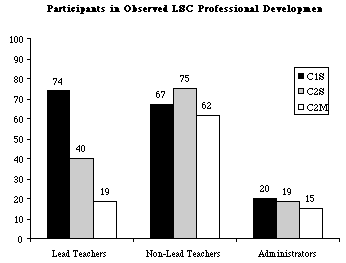
Figure 71
In terms of groups external to the district systems, LSC projects appear to enjoy the support of science-rich institutions and institutions of higher education. Cohort 2 projects are much more likely than Cohort 1 projects to have the active support of business and industry, but neither Cohort 1 nor Cohort 2 projects are likely to have a great deal of active support for reform from parents.
Evaluators were also asked to rate the extent to which district policies and practices tended to facilitate reform or act as barriers for reform. As can be seen in Figure 72, the most frequent facilitators of reform in LSC districts are the professional development systems; the curriculum, scope and sequence; the fact that the various reform efforts are consistent with one another; and the quality of instructional materials.
Range of Projects Where Evaluators Report Each Factor Facilitates Reform
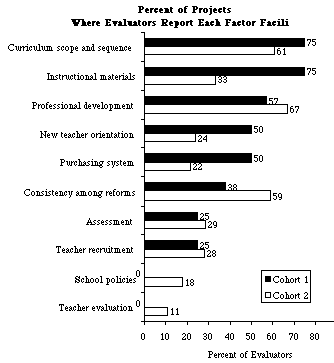
Figure 72
Cohort 1 districts received higher marks than Cohort 2 districts in a number of areas, including the quality of instructional materials and new teacher orientation. In contrast, Cohort 2 districts tended to be more highly rated in terms of consistency among reforms. In both cohorts, teacher evaluation policies and within-school policies such as time for teacher to plan and prepare lessons were rarely seen as facilitators of reforms.
Evaluators were asked to summarize their findings by placing each project at the appropriate point on a continuum of 'supportiveness of context'. As can be seen in Table 26, most projects in each cohort were considered 'transitioning toward a supportive context.'
Table 26
Continuum Rating for Supportiveness of Context
|
Percent of Projects |
|
Cohort 1 |
Cohort 2 |
| Level 1: Predominance of Non-Supportive Context | 0 | 0 |
| Level 2: Minimally Supportive Context | 25 | 0 |
| Level 3: Transitioning Toward Supportive Context | 63 | 72 |
| Level 4: Emerging Supportive Context | 13 | 28 |
| Level 5: Predominance of Supportive Context | 0 | 0 |
A number of evaluators spoke of the commitment the districts had made to aligning their policies in support of the LSC reforms.
"Districts have given [LSC project] leaders and connected curriculum review groups the responsibility of revising the district science standards and aligning them with the emerging state [frameworks] in science."
"All five districts actively support the project's highly effective centralized resource center that stores, delivers, and refurbishes the kits for classroom use."
"The district's recent decision to adopt new standards-based science and mathematics materials demonstrates a willingness to work in conjunction with, if not in direct support of, the goals of the LSC."
"The district has purchased kits which are already in use in some schools, and the district has made a major commitment to purchase more. Efforts are underway to create a system for purchasing and managing materials and supplies."
"[Site] has many important elements of a strong science program in place, including an articulated curriculum based on state and national standards, science kits with supplies/equipment and printed guidebooks to support curriculum, and a fully staffed resource center to maintain and distribute the kits. Additionally, the district has a full-time curriculum director and a full-time science coordinator. This represents a major, initial, and on-going investment in science and reflects the long-term commitment to improving science learning and teaching."
In other cases, evaluators noted that there had been major improvements in the availability of materials for hands-on instruction, but the improvements appeared project-based rather than rooted in district commitments.
"Prior to joining [the project], teachers bought their own science materials or, in some cases, districts provided materials. Currently, [the project] assembles, delivers, picks up, and refurbishes materials, greatly reducing the burden on teachers and districts."
Finally, some evaluators in other projects reported that financial difficulties pose serious problems for reform in the districts.
"[Our site] is implementing its LSC within the context of depressing and undermining budget cuts and staff readjustments. The position of teacher expert has disappeared form the system, vice principals have been cut, and much professional development has been eliminated."
"A lack of materials has been prohibitive-since these schools started with no materials, they will need to make future investments for several years."
"Currently, many teachers are forced to supplement their stock of materials with items purchased with their own money. They look forward to the time when all classrooms will be equipped with adequate materials."
Footnotes
1 In order to receive a "perfect" score on the parent support composite, a teacher would have had to indicate that "almost all" of their students' parent volunteer, donate money, etc.
| 
